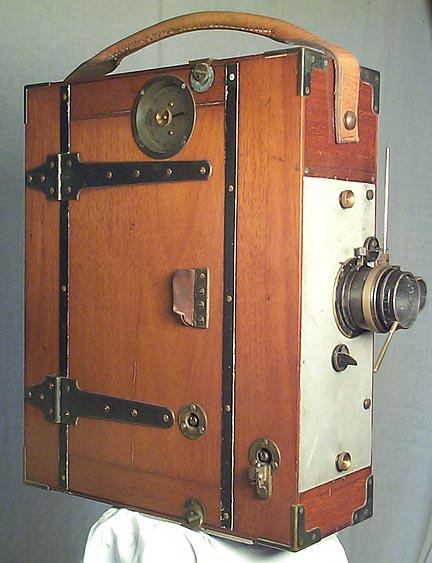PRICE ON REQUEST
It is said that the first picture shot in Hollywood was shot with a Moy. It's a shame no one knows which Moy it was. Records from the earliest days are so very scarce. I'd like to think it is this Moy as it was found in the rafters of a garage of an old house in L.A. about 1965.
If you look at the other Moy cameras on my web site you will see that I have #370 along with #366. I acquired these cameras years apart. I'd bet good money that these two cameras were together on the work bench at the factory when new. I think of this as something like old brothers reunited. I keep them next to each other in my shop. I hope they both end up with the same caretaker after me. It would be nice if they could stay together.
I'm writing a little here about the Moy & Bastie factory and Mr. Ernest Moy and Mr. Percy Henry Bastie. This camera will pretty much take care of itself through the pictures.
Moy & Bastie started their company by making circuit breakers in 1895. In 1896 they met Robert Paul and started working with him making items for the new business of motion pictures.
In 1897 and 1898 Moy applied for and was granted patents for motion picture equipment. They made their first camera for sale to the market in 1900. In 1905 they sold Captain Scott the camera he took on his ill-fated Antarctic expedition. In 1907 they started working with Charles Urban helping to develop Kinemacolor, the first color process. The process was too complicated to be practical but had a good measure of success.
In 1909 they geared up to manufacture the cameras seen here on this web site. They were very efficient and extremely reliable machines. The camera was so successful in the industry that they became the camera of choice and were seen in use on almost every set, filming news, comedies and actualities the world over.
I work on all the cameras on my web site and the Moy is my most favorite of the early cinema cameras. It is solid and effective. The chain drive and drunken screw mechanism are mechanical genius and certainly led to the camera's popularity.
The camera had dominance up until the end of World War I when the Bell and Howell and Pathe cameras took over as the cameras of choice for the industry.
Earnest Moy died in 1926 but Percy Henry Bastie kept the company in the forefront of the industry using their electrical expertise to manufacture sound equipment in the new age of sound.
I have left #366 almost exactly as I received it. I cleaned it and worked on getting the bronze disease out of the camera and gave it a good lubrication and a new leather strap. This is an amazing camera.
